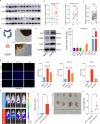Influential upregulation of KCNE4: Propelling cancer associated fibroblasts-driven colorectal cancer progression
- PMID: 38462626
- PMCID: PMC10926681
- DOI: 10.1186/s12935-024-03274-9
Influential upregulation of KCNE4: Propelling cancer associated fibroblasts-driven colorectal cancer progression
Abstract
Background: Colorectal cancer (CRC) is a malignancy of remarkable heterogeneity and heightened morbidity. Cancer associated fibroblasts (CAFs) are abundant in CRC tissues and are essential for CRC growth. Here, we aimed to develop a CAF-related classifier for predicting the prognosis of CRC and identify critical pro-tumorigenic genes in CAFs.
Method: The mRNA expression and clinical information of CRC samples were sourced from two comprehensive databases, The Cancer Genome Atlas (TCGA) and Gene Expression Omnibus (GEO). Using a weighted gene co-expression network analysis (WGCNA) approach, CAF-related genes were identified and a CAF risk signature was developed through the application of univariate analysis and the least absolute shrinkage and selection operator (LASSO) Cox regression model. EdU cell proliferation assay, and transwell assay were performed to detect the oncogenic role of KCNE4 in CAFs.
Results: We constructed a prognostic CAF model consisting of two genes (SFRP2 and KCNE4). CRC patients were classified into low- and high-CAF-risk groups using the median CAF risk score, and patients in the high-CAF-risk group had worse prognosis. Meanwhile, a higher risk score for CAFs was associated with greater stromal and CAF infiltrations, as well as higher expression of CAF markers. Furthermore, TIDE analysis indicated that patients with a high CAF risk score are less responsive to immunotherapy. Our further experiments had confirmed the strong correlation between KCNE4 and the malignant phenotypes of CAFs. Moreover, we had shown that KCNE4 could actively promote tumor-promoting phenotypes in CAFs, indicating its critical role in cancer progression.
Conclusion: The two-gene prognostic CAF signature was constructed and could be reliable for predicting prognosis for CRC patients. Moreover, KCNE4 may be a promising strategy for the development of novel anti-cancer therapeutics specifically directed against CAFs.
Keywords: Adhesion; Cancer-associated fibroblasts (CAFs); Colorectal cancer (CRC); KCNE4; Migration.
© 2024. The Author(s).
Conflict of interest statement
The authors declare no competing interests.
Figures







References
-
- Siegel RL, Miller KD, Fuchs HE, Jemal A. Cancer Statistics, 2021. CA: a cancer journal for clinicians 2021, 71(1):7–33. - PubMed
-
- Jackstadt R, van Hooff SR, Leach JD, Cortes-Lavaud X, Lohuis JO, Ridgway RA, Wouters VM, Roper J, Kendall TJ, Roxburgh CS, et al. Epithelial NOTCH Signaling rewires the Tumor Microenvironment of Colorectal Cancer to drive poor-prognosis subtypes and metastasis. Cancer Cell. 2019;36(3):319–336e317. doi: 10.1016/j.ccell.2019.08.003. - DOI - PMC - PubMed
-
- Nishina T, Deguchi Y, Ohshima D, Takeda W, Ohtsuka M, Shichino S, Ueha S, Yamazaki S, Kawauchi M, Nakamura E, et al. Interleukin-11-expressing fibroblasts have a unique gene signature correlated with poor prognosis of colorectal cancer. Nat Commun. 2021;12(1):2281. doi: 10.1038/s41467-021-22450-3. - DOI - PMC - PubMed
Grants and funding
LinkOut - more resources
Full Text Sources

